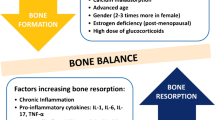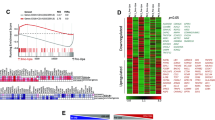Abstract
Objective
To detect the effect of interleukin (IL)-34 on the secretion of Receptor activator of nuclear factor kappa-B ligand (RANKL)/Osteoprotegerin (OPG) and Matrix metalloproteinase (MMP)-3 by fibroblast-like synoviocytes (FLS) and peripheral blood mononuclear cells (PBMCs) of rheumatoid arthritis (RA) patients and to investigate whether the effect is mediated by IL-17.
Method
RA-FLS and RA-PBMCs were stimulated with recombinant human (rh) IL-34, with or without the IL-17 inhibitor Plumbagin. The supernatant of the culture medium was collected and the levels of RANKL, OPG, and MMP-3 were detected by enzyme-linked immunosorbent assay (ELISA).
Results
RhIL-34 promoted RANKL secretion and inhibited OPG secretion in RA-FLS. The effect was weakened by the addition of the IL-17 inhibitor. In contrast, rhIL-34 had no significant effect on MMP-3 secretion by FLS. RhIL-34 elevated the secretion of RANKL by RA-PBMCs but not by healthy-PBMCs. Furthermore, the secretion of RANKL by RA-PBMCs reduced after the addition of the IL-17 inhibitor. OPG secretion by both RA-FLS and FLS from healthy controls was inhibited by rhIL-34, but were elevated after the addition of the IL-17 inhibitor. RhIL-34 had no significant effect on MMP-3 secretion by both RA-PBMCs and healthy-PBMCs.
Conclusion
IL-34 enhances RANKL/OPG expression by RA-FLS and RA-PBMCs, and this effect is, indirectly, mediated by IL-17. This cytokine is therefore likely to to play an important role in local joint destruction and systemic osteoporosis in RA, and is therefore a potential therapeutic target for the treatment of this disease.
Similar content being viewed by others
References
Firestein GS. Evolving concepts of rheumatoid arthritis. Nature 2003; 423(6937): 356–61.
Rommel C, Camps M, Ji H. PI3K delta and PI3K gamma: partners in crime in inflammation in rheumatoid arthritis and beyond? Nat Rev Immunol 2007; 7(3): 191–201.
Das S, Padhan P. An overview of the extraarticular involvement in rheumatoid arthritis and its management. J Pharmacol Pharmacother 2017; 8(3): 81–6.
Lee DM, Kiener HP, Agarwal SK, et al. Cadherin-11 in synovial lining formation and pathology in arthritis. Science 2007; 315 (5814): 1006–10.
Agarwal S, Misra R, Aggarwal A. Synovial fluid RANKL and matrix metalloproteinase levels in enthesitis related arthritis subtype of juvenile idiopathic arthritis. Rheumatol Int 2009; 29 (8): 907–11.
Ainola M, Mandelin J, Liljeström M, Konttinen YT, Salo J. Imbalanced expression of RANKL and osteoprotegerin mRNA in pannus tissue of rheumatoid arthritis. Clin Exp Rheumatol 2008; 26(2): 240–6.
Hensvold AH, Joshua V, Li W, et al. Serum RANKL levels associate with anti- citrullinated protein antibodies in early untreated rheumatoid arthritis and are modulated following methotrexate. Arthritis Res Ther 2015; 17: 239.
Kotake S, Udagawa N, Hakoda M, et al. Activated human T cells directly induce osteoclastogenesis from human monocytes: possible role of T cells in bone destruction in rheumatoid arthritis patients. Arthritis Rheum 2001; 44(5): 1003–12.
Hashizume M, Hayakawa N, Mihara M. IL-6 trans-signalling directly induces RANKL on fibroblast-like synovial cells and is involved in RANKL induction by TNF-alpha and IL-17. Rheumatology (Oxford) 2008; 47(11): 1635–40.
Kong YY, Yoshida H, Sarosi I, et al. OPGL is a key regulator of osteoclastogenesis, lymphocyte development and lymph-node organogenesis. Nature 1999; 397(6717): 315–23.
Zhou L, Wang G, Liu X, Song J, Chen L, Xu H. Matrix metalloproteinase-3 and the 7-joint ultrasound score in the assessment of disease activity and therapeutic efficacy in patients with moderate to severe rheumatoid arthritis. Arthritis Res Ther 2017; 19(1): 250.
Matsuno H, Yudoh K, Watanabe Y, Nakazawa F, Aono H, Kimura T. Stromelysin-1 (MMP-3) in synovial fluid of patients with rheumatoid arthritis has potential to cleave membrane bound Fas ligand. J Rheumatol 2001; 28(1): 22–8.
Ribbens C, Andre B, Kaye O, et al. Synovial fluid matrix metalloproteinase-3 levels are increased in inflammatory arthritides whether erosive or not. Rheumatology (Oxford) 2000; 39(12): 1357–65.
Kageyama Y, Miyamoto S, Ozeki T, Hiyohsi M, Suzuki M, Nagano A. Levels of rheumatoid factor isotypes, metalloproteinase- 3 and tissue inhibitor of metalloproteinase-1 in synovial fluid from various arthritides. Clin Rheumatol 2000; 19(1): 14–20.
Dong C. Diversification of T-helper-cell lineages: finding the family root of IL-17-producing cells. Nat Rev Immunol 2006; 6(4): 329–33.
Miao J, Geng J, Zhang K, et al. Frequencies of circulating IL-17- producing CD4+CD161+ T cells and CD4+CD161+ T cells correlate with disease activity in rheumatoid arthritis. Mod Rheumatol 2014; 24(2): 265–570.
van Hamburg JP, Asmawidjaja PS, Davelaar N, et al. Th17 cells, but not Th1 cells, from patients with early rheumatoid arthritis are potent inducers of matrix metalloproteinases and proinflammatory cytokines upon synovial fibroblast interaction, including autocrine interleukin-17A production. Arthritis Rheum 2011; 63(1): 73–83.
Koenders MI, Kolls JK, Oppers-Walgreen B, et al. Interleukin- 17 receptor deficiency results in impaired synovial expression of interleukin-1 and matrix metalloproteinases 3, 9, and 13 and prevents cartilage destruction during chronic reactivated streptococcal cell wall-induced arthritis. Arthritis Rheum 2005; 52(10): 3239–47.
Koenders MI, Marijnissen RJ, Devesa I, et al. Tumor necrosis factor-interleukin-17 interplay induces S100A8, interleukin-1b, and matrix metalloproteinases, and drives irreversible cartilage destruction in murine arthritis: rationale for combination treatment during arthritis. Arthritis Rheum 2011; 63(8): 2329–39.
Kim KW, Kim HR, Kim BM, Cho ML, Lee SH. Th17 cytokines regulate osteoclastogenesis in rheumatoid arthritis. Am J Pathol 2015; 185(11): 3011–24.
Chemel M, Le Goff B, Brion R, et al. Interleukin 34 expression is associated with synovitis severity in rheumatoid arthritis patients. Ann Rheum Dis 2012; 71(1): 150–4.
Chang SH, Choi BY, Choi J, et al. Baseline serum interleukin-34 levels independently predict radiographic progression in patients with rheumatoid arthritis. Rheumatol Int 2015; 35(1): 71–9.
Zhou RP, Wu XS, Xie YY, et al. Functions of interleukin-34 and its emerging association with rheumatoid arthritis. Immunology 2016; 149(4): 362–73.
Wang B, Ma Z, Wang M, et al. IL-34 upregulated Th17 production through increased IL-6 expression by rheumatoid fibroblast-like synoviocytes. Mediat Inflamm 2017; 2017: 1567120.
Tian Y, Shen H, Xia L, Lu J. Elevated serum and synovial fluid levels of interleukin-34 in rheumatoid arthritis: possible association with disease progression via interleukin-17 production. J Interferon Cytokine Res 2013; 33(7): 398–401.
Abimannan T, Peroumal D, Parida JR, Barik PK, Padhan P, Devadas S. Oxidative stress modulates the cytokine response of differentiated Th17 and Th1 cells. Free Radic Biol Med 2016; 99: 352–63.
Villeneuve E, Nam J, Emery P. 2010 ACR-EULAR classification criteria for rheumatoid arthritis. Rev Bras Reumatol 2010; 50(5): 481–3.
Chen Z, Buki K, Vaaraniemi J, Gu G, Vaananen HK. The critical role of IL-34 in osteoclastogenesis. PLoS One 2011; 6(4): e18689.
Hwang SJ, Choi B, Kang SS, et al. Interleukin-34 produced by human fibroblast-like synovial cells in rheumatoid arthritis supports osteoclastogenesis. Arthritis Res Ther 2012; 14(1): R14.
Baud’huin M, Renault R, Charrier C, et al. Interleukin-34 is expressed by giant cell tumours of bone and plays a key role in RANKL-induced osteoclastogenesis. J Pathol 2010; 221(1): 77–86.
Kotake S, Udagawa N, Takahashi N, et al. IL-17 in synovial fluids from patients with rheumatoid arthritis is a potent stimulator of osteoclastogenesis. J Clin Invest 1999; 103(9): 1345–52.
Van Bezooijen RL, Papapoulos SE, Löwik CW. Effect of interleukin-17 on nitric oxide production and osteoclastic bone resorption: is there dependency on nuclear factor-kappaB and receptor activator of nuclear factor kappaB (RANK)/RANK ligand signaling? Bone 2001; 28(4): 378–86.
Ganesan R, Rasool M. Interleukin 17 regulates SHP-2 and IL- 17RA/STAT-3 dependent Cyr61, IL-23 and GM-CSF expression and RANKL mediated osteoclastogenesis by fibroblast-like synoviocytes in rheumatoid arthritis. Mol Immunol 2017; 91: 134–44.
Fischer JA, Hueber AJ, Wilson S, et al. Combined inhibition of tumor necrosis factor a and interleukin-17 as a therapeutic opportunity in rheumatoid arthritis: development and characterization of a novel bispecific antibody. Arthritis Rheumatol 2015; 67(1): 51–62.
Wang B, Tang Y, Sun X, et al. Increased IL-6 expression on THP-1 by IL-34 stimulation up-regulated rheumatoid arthritis Th17 cells. Clin Rheumatol 2018; 37(1): 127–37.
Foucher ED, Blanchard S, Preisser L, et al. IL-34- and M-CSFinduced macrophages switch memory T cells into Th17 cells via membrane IL-1a. Eur J Immunol 2015; 45(4): 1092–102.
Bolon B, Carter C, Daris M, et al. Adenoviral delivery of osteoprotegerin ameliorates bone resorption in a mouse ovariectomy model of osteoporosis. Mol Ther 2001; 3(2): 197–205.
Simonet WS, Lacey DL, Dunstan CR, et al. Osteoprotegerin: a novel secreted protein involved in the regulation of bone density. Cell 1997; 89(2): 309–19.
Nagai M, Sato N. Reciprocal gene expression of osteoclastogenesis inhibitory factor and osteoclast differentiation factor regulates osteoclast formation. Biochem Biophys Res Commun 1999; 257(3): 719–23.
Deyama Y, Takeyama S, Koshikawa M, et al. Osteoblast maturation suppressed osteoclastogenesis in coculture with bone marrow cells. Biochem Biophys Res Commun 2000; 274(1): 249–54.
Quinn JM, Horwood NJ, Elliott J, Gillespie MT, Martin TJ. Fibroblastic stromal cells express receptor activator of NF-kappa B ligand and support osteoclast differentiation. J Bone Miner Res 2000; 15(8): 1459–66.
van Nieuwenhuijze AE, van de Loo FA, Walgreen B, et al. Complementary action of granulocyte macrophage colony-stimulating factor and interleukin-17A induces interleukin-23, receptor activator of nuclear factor-kB ligand, and matrix metalloproteinases and drives bone and cartilage pathology in experimental arthritis: rationale for combination therapy in rheumatoid arthritis. Arthritis Res Ther 2015; 17: 163.
Siebuhr AS, Kjelgaard-Petersen CF, Sun S, et al. Suppression of active, but not total MMP-3, is associated with treatment response in a phase III clinical study of rheumatoid arthritis. Clin Exp Rheumatol 2018; 36(1): 94–101.
Moon SJ, Hong YS, Ju JH, Kwok SK, Park SH, Min JK. Increased levels of interleukin 34 in serum and synovial fluid are associated with rheumatoid factor and anticyclic citrullinated peptide antibody titers in patients with rheumatoid arthritis. J Rheumatol 2013; 40(11): 1842–9.
Stern A, Laughlin GA, Bergstrom J, Barrett-Connor E. The sexspecific association of serum osteoprotegerin and receptor activator of nuclear factor kappaB legend with bone mineral density in older adults: the Rancho Bernardo study. Eur J Endocrinol 2007; 156(5): 555–62.
Jabbar S, Drury J, Fordham JN, Datta HK, Francis RM, Tuck SP. Osteoprotegerin, RANKL and bone turnover in postmenopausal osteoporosis. J Clin Pathol 2011; 64(4): 354–7.
Zhang F, Ding R, Li P, et al. Interleukin-34 in rheumatoid arthritis: potential role in clinical therapy. Int J Clin Exp Med 2015; 8(5): 7809–15.
Tat SK, Pelletier JP, Velasco CR, Padrines M, Martel-Pelletier J. New perspective in osteoarthritis: the OPG and RANKL system as a potential therapeutic target? Keio J Med 2009; 58(1): 29–40.
Author information
Authors and Affiliations
Corresponding author
Additional information
This study was supported by a grant from the National Natural Science Foundation of China (No. 81373219).
About this article
Cite this article
Cui, M.y., Li, X., Lei, Y.m. et al. Effects of IL-34 on the secretion of RANKL/OPG by fibroblast-like synoviocytes and peripheral blood mononuclear cells in rheumatoid arthritis. Eur Cytokine Netw 30, 67–73 (2019). https://doi.org/10.1684/ecn.2019.0428
Accepted:
Published:
Issue Date:
DOI: https://doi.org/10.1684/ecn.2019.0428




